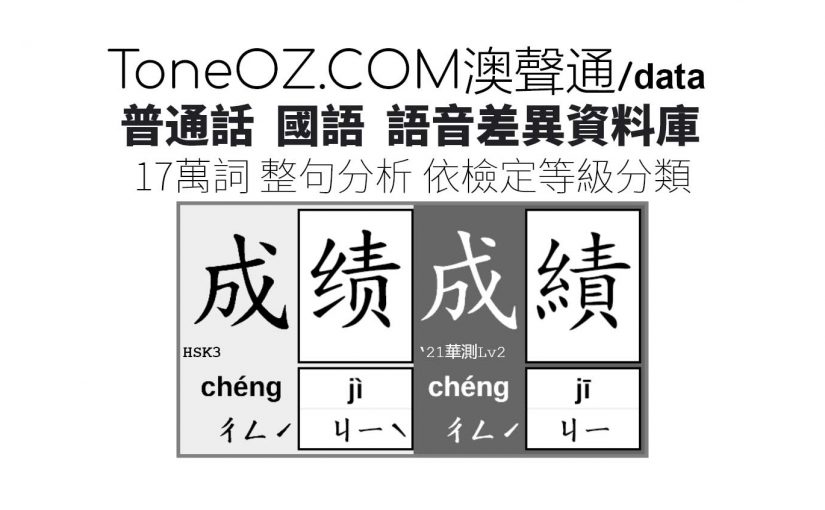普通話 國語 兩岸語音的不同
17萬詞 依檢定等級查詢
ToneOZ的全系列工具都有「普通話」及「國語」兩岸多音差異切換設定,可辨識出六千多個詞有語音差異,來自 526 個中文字 。
- 文本字型編輯器 toneoz.com/ime 可在您貼上一整篇文章的瞬間,用紅色雙底線標示出哪些字存在兩岸多音差異。
- 語音差異詞庫 toneoz.com/data 是一個索引,可以列出所有多音差異的六千多詞, 526 個中文字 。索引的詳細使用法 請見後文「索引使用方法」。
- 全圖像式編輯器 toneoz.com 的左下角選單有「普通話」及「國語」選項可切換。
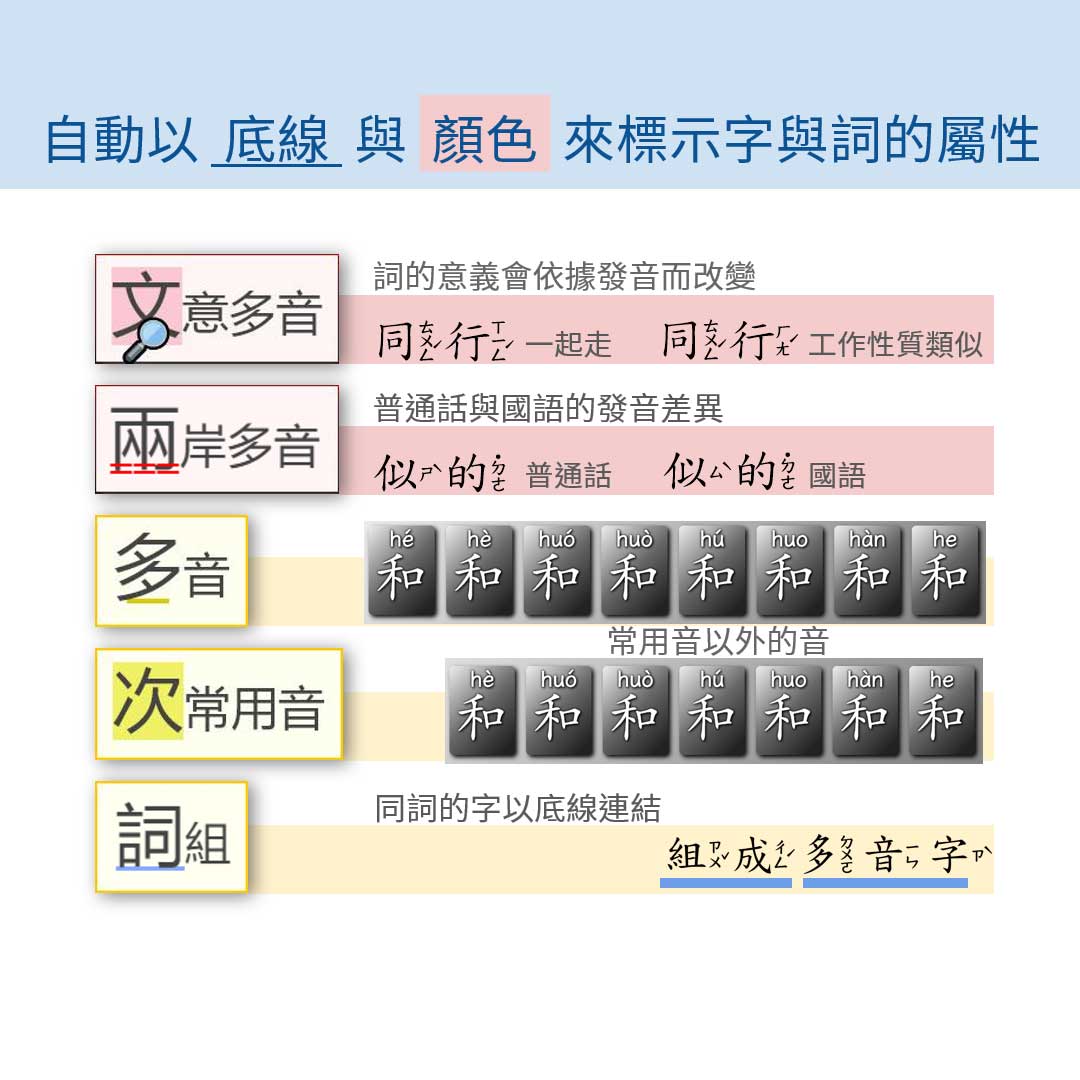
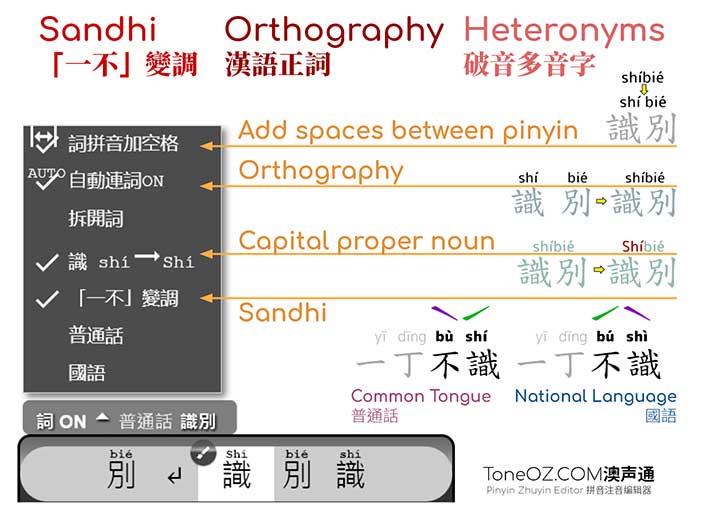
About differences pronunciation between “Pǔtōnghuà (Common Tongue) and Guóyǔ (National Language)”
什麼是「普通話與國語語音差異」?
There are two major systems in Mandarin Chinese: The Mainland uses “Simplified Chinese Characters” with accent “Pǔtōnghuà (Common Tongue)” and the phonetic symbol “Pinyin”, while Taiwan uses “Traditional Chinese Characters” with accent “Guóyǔ (National Language)” and the phonetic symbol “Zhuyin”. The pronunciation standards of these two systems are developed by different authorities and experts. Differences therefore exist between these two systems.
中文有兩大標準規範:大陸書寫使用「簡體字」搭配語音「普通話」及符號「漢語拼音」,台灣書寫使用「繁體字」搭配語音「國語」及符號「注音」。 由不同地區的教育主管單位分別制定兩者的語音標準,因而存在差異。
Simplified Chinese 簡體字 | Pinyin 漢語拼音 | Common Tongue 普通話 |
Traditional Chinese 繁體字 | Zhuyin 注音 | National Language 國語 |
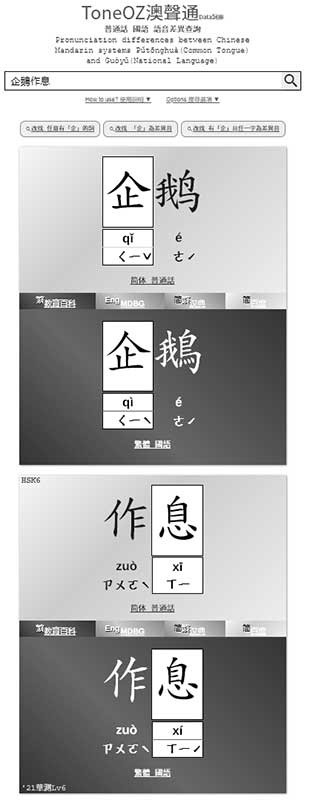
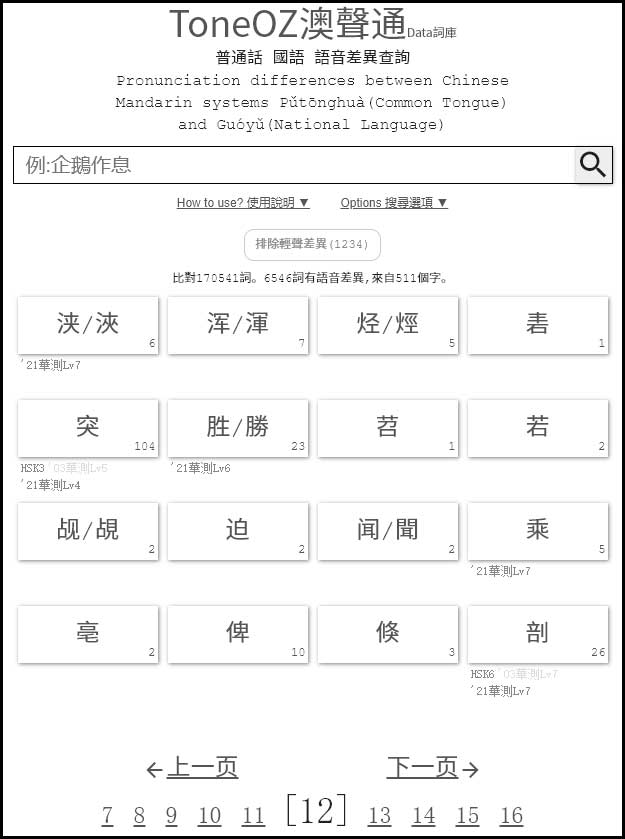
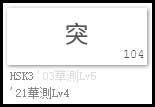
華語文能力測驗TOCFL
“ToneOZ.COM/Data” is a pronunciation differences database for the two Mandarin systems, Common Tongue and the National Language. In 2021 we collected 170k mandarin vocabulary entries from the Chinese dictionaries “CC-CEDICT”, “National Language Dictionary”, and “Jieba” the Chinese words segmentation system. 513 characters in 6k vocabularies have been identified with different pronunciation between Common Tongue and National Language. We created a search engine service in ToneOZ.com/data for these data, including a words index and a parsing mode.
「澳聲通詞庫」是以通行現代的漢語語音來比對普通話與國語的語音差異。 2021年我們以三個不同的漢語詞庫為基礎(CC-CEDICT, Jeiba, 國語辭典簡編本), 比對 17萬 個中文詞彙的普通話與國語。 經過逐一校對後,我們找到 六千 多個詞有語音差異,來自 526 個中文字。 我們以搜尋引擎的形式,將研究成果公開在 ToneOZ.com/data, 免費提供索引及整句分析。
The word index mode lists all the words with pronunciation difference, and their source phrases. The parse mode allow the user to type in a whole Chinese sentence. We will parse it into Chinese words/phrases and highlight the pronunciation differences.
索引模式列出所有有差異音的中文字及來源詞彙,整句分析模式允許使用者可輸入一整句中文,搜尋引擎會自動標示出差異音的位置。
“ToneOZ.COM/Data” is for the future extension function of our another web service “Phonetic Chinese Article Editor ToneOZ.COM“
「澳聲通詞庫」是為了「拼音注音編輯器 ToneOZ.COM」所預備製作的擴充功能。
“Multicultural Policy” is one of the most important commitments in the Australia Education System. Australia schools value the community harmony, intercultural understanding development, and inclusive teaching practices. Over a hundred years, Chinese immigrants from different regions with different cultural backgrounds have joined this country, and now is the second largest migrant community in Australia. By these Australia shared values, “ToneOZ” builds tools and Apps for Chinese teaching with different varieties.
過去一百多年間有來自不同區域不同文化背景的華人在澳洲落腳生根,澳洲2016人口普查顯示華語僅次於英文為第二大通行語言,佔2.5%。澳大利亞的教育精神是強調民族多樣性,包容性,肯定多元文化。澳洲保留各語言的特色,同時增進不同語言使用者之間的相互了解, 維持族群和諧。「澳聲通」以這樣的澳洲價值為出發點,來製作符合不同背景的教學工具。
Data Quality Assurance
原始數據是怎麼來的?如何確保正確性?
In order to eliminate the errors, ToneOZ uses multiple open sources or public Chinese dictionaries to compare with each other, and then manually review all the differences. We choose our data sources by 3 key points:
「澳聲通詞庫」分別從「量大、質佳、通用」三方面來確保詞庫的正確性。 我們利用多種開放公眾使用的中文語音來源相互比對,審核語音差異的部分,排除各辭典的邏輯編輯錯誤以及破音字:
- Quantity「量大17萬詞」
We use the mainstream dictionaries with high words coverage:
我們的數據來自數個中文教學時最常用的詞庫 :
1. CC-CEDICT , an English-Chinese dictionary since 1997.
(英語世界最大的 Open Source 英漢辭典)
2. Jieba, Chinese text segmentation system.
(大陸結巴中文分詞系統)
3. 國語辭典簡編本, Ministry of Education Mandarin Chinese Dictionary
(國語教學標準字典) - Quality「質佳」
We verify the pronunciation with official documents :
語音資料的查證參考以下各教育主管機關的標準文件 :
a. 普通話異讀詞審音表
(1985年版, 大陸《普通話水平測試》標準)
b. 國語一字多音審訂表
(1999年版, 台灣中文教學標準)
c. 國語辭典簡編本
(台灣現代語音)
d. 國語辭典重編本
(台灣古典語音)
e. CC-CEDICT
(2020年版, 普通話拼音, 英語地區漢語教學常用) - Modern Chinese「通用」
While conflict occur, we verify with the pronunciation from the local News or entertainment video programs:
語音差異部分的查核,是透過搜尋引擎或影音平台,與當地電視節目主播的發音做比對 :
i. Baidu 百度
ii. Tencent 騰訊
iii. Youtube
資料來源授權
“ToneOZ Database” uses the following data sources under the condition of “Collection (encyclopedias)”:
「澳聲通詞庫」是以「彙編 」(百科全書)的形式來使用以下網路詞庫授權。我們僅使用詞語及語音資料,未使用辭典內任何詞語註釋:
- Source 1. CC-CEDICT:
By : cc-cedict.org
License: CC BY-SA 4.0 - Source 2. Jieba:
By : FXSJY
License : MIT - Source 3. 國語辭典:
By : language.moe.gov.tw
License : CC BY-ND 3.0
「澳聲通詞庫」本身的使用授權
About the license of the “ToneOZ Dabase” :
「澳聲通詞庫」本身包含兩種創作,只有第一種開放授權:
1. The text and pronunciation data in this ”ToneOZ Database“ are licensed under a Creative Commons Attribution-ShareAlike 4.0 International License (CC BY-SA 4.0) (data download) , while the original data are licensed from Sources 1,2, and 3 as mentioned above.
中文繁簡詞彙與語音資料採用「創用CC姓名標示BY相同方式分享SA」授權。 您可免費使用「澳聲通詞庫(下載)」,個人或商業使用均可。
2. The external lookup table (Traditional, Simplified, Phonetic Chinese) and the search program in this “ToneOZ Database” are parts of another tool “Phonetic Chinese Article Editor ToneOZ.COM“. They are copyright protected intellectual properties of the Australian company “Tone A To Z”. Copy or link to these libraries are prohibited.
數據庫以外的繁簡發音查表及搜尋引擎程序,屬於本公司的另一個教學工具「拼音注音編輯器 ToneOZ.COM」,尚未開放授權第三方使用。
Index Usage
索引使用方法
There are two major systems in Mandarin Chinese: The Mainland uses “Simplified Chinese Characters” with accent “Pǔtōnghuà (Common Tongue)”, while Taiwan uses “Traditional Chinese Characters” with accent “Guóyǔ (National Language)”. The standard of the pronunciations of these two systems are developed by different authorities and experts. Differences therefore exist between these two systems.
中文有兩大標準規範:大陸書寫使用「簡體字」搭配語音「普通話」,台灣書寫使用「繁體字」搭配語音「國語」。 由不同地區的教育主管單位分別制定兩者的語音標準,因而存在差異。
There could be more than one pronunciation for a single Chinese word/phrase, depending on the words before and after in a sentence. ToneOZ has reviewed all of the options to identify which word/phrase has a regional pronunciation difference. If there is, we will only show that case in the search result.
漢語字詞可能有一種或多種多音字唸法。「澳聲通詞庫」會將字詞的所有唸法及使用情境都加以考慮, 來決定是否有兩岸語音差異。在顯示查詢結果時,我們會優先顯示有兩岸語音差異的唸法。若語音沒有差異,我們會列出”較常用的其中一種語音”作為範例。 詳細字詞解釋及唸法請參閱外部辭典連結。
Index Mode
「索引列表」列出全部差異音字
In default (leave the search box blank), ToneOZ will show an index list of all the words with pronunciation differences. E.g.:
不輸入任何字直接查詢,會索引列出所有存在差異音的字。例如下圖:
The word 「渾」has pronounciation difference in 7 phrases
「渾」這個字找到 7個詞有語音差異。
The word 「突」is listed in HSK and TOCFL
「突」這個字則在 HSK 及 華測 檢定考試中有出現。

Click any word in the index list to show all the phrases. E.g.: 「烴」
點選任一個索引字便會列出所有語音差異詞,例如點選「烴」這個字便會列出5個詞含有「烴」且語音有差異:
「烴」is “qīng” in National Language
國語唸「qīng ㄑㄧㄥ」
「烴」is “tīng” in Common Tongue
普通話唸「tīngㄊㄧㄥ」

Parse Mode
「整句查詢」繁簡詞語語音
Type in a Chinese Sentence to parse which words/phrases have pronunciation differences. E.g.: 「企鵝作息」will be parsed as 2 phrases 「企鵝」and「作息」, then the words「企」and「息」will be highlighted as they have pronunciation differences.
繁簡中文均可,可混用。例如輸入「企鵝作息」,澳聲通詞庫可辨識出「企鵝」「作息」兩個詞,並指出「企」「息」這兩個字的普通話與國語語音有差異。 若分詞失誤,請在詞彙前插入空格,例如輸入「廿日記載」會得到「廿、日記、載」,此時請在中間加入空格「廿日 記載」便可得到「廿、日、記載」其中「載」存在語音差異。

Options 搜尋選項
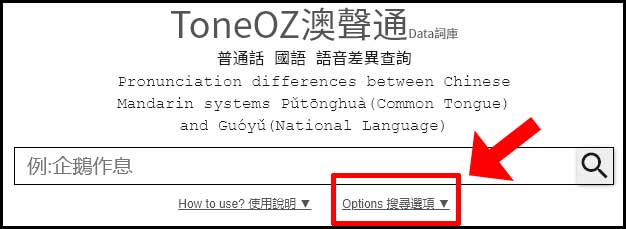
We have 3 options:
有三種進階選項:
- Differences position
「差異音位置」 - Neutral tone
「輕聲差異」 - Words Source
「詞源」
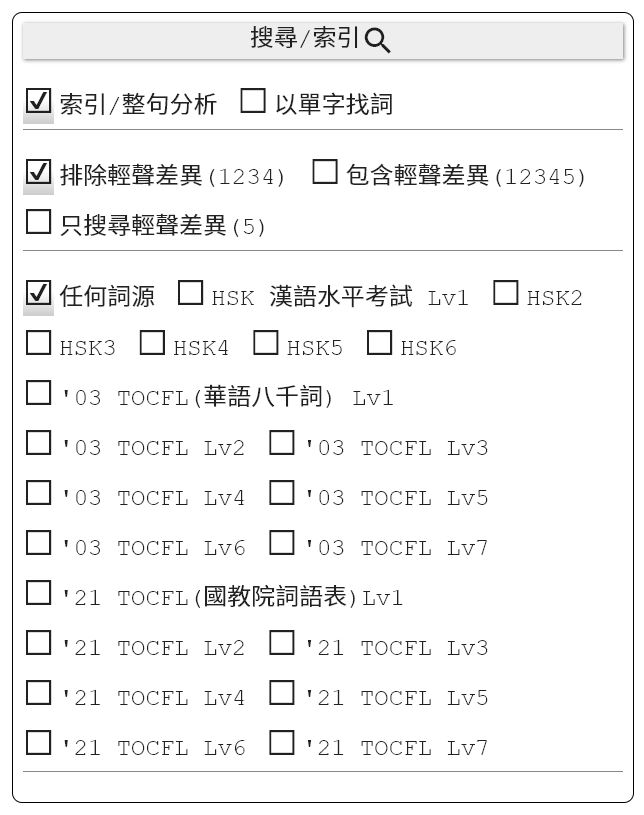
Differences position
差異音位置
For example, the word 「養」:
舉例:如果我們想研究「養」這個字 :
Any contain
「包含單字的詞」
Search phrases contain the word 「養」, no matter the pronunciation difference it has or not. E.g.: You can get 「休養」 although this phrase does no have any difference in the pronunciation.
可以找出所有包含「養」這個字的詞,無論有或沒有語音差異。例如找到「休養」這個詞,沒有語音差異。
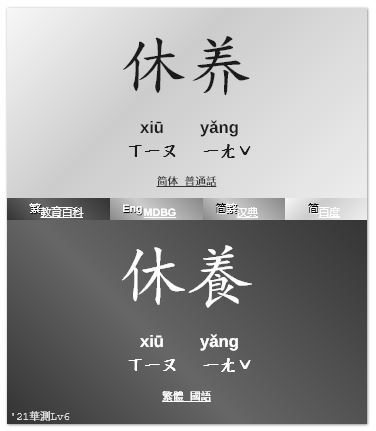
Contain & diff
「包含單字,單字也為差異音」
Search and 「養」must be pronounced differently. E.g.: You can get 「供養」because the word 「養」has different pronunciation in this phrase「供養」. It is tone 3 in Common Tongue, but it is tone 4 in National Language.
可找到「養」語音有差異的詞。例如「供養」的「養」在國語中聲調變為4聲,普通話的聲調仍然維持3聲。
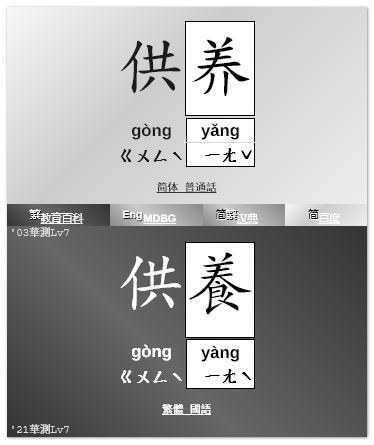
Contain & diff in any word
「包含單字,詞中任意字為差異音」
Search 「養」, and any other word in the same phrase has a pronounciation difference. E.g.: 「休養生息」contains 「養」but no diff in the pronounciation, however it contains 「息」that has a difference. It is tone 1 in Common Tongue, but it is tone 2 in National Language.
可找到有包含「養」,且任何字有語音差異的詞。例如找到「休養生息」,「養」沒有語音差異,「息」國語為2聲,普通話為1聲。
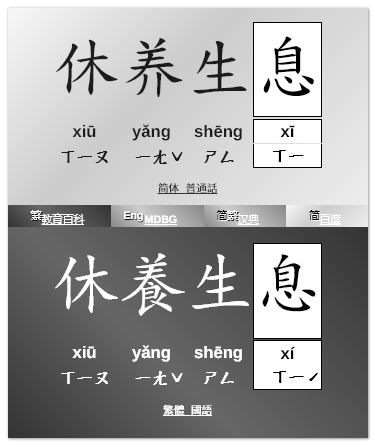
Neutral tone
輕聲差異
Neutral tone (Tone 5) is a special tone in Chinese, in comparison with other 4 tones (1 high 2 rising 3 low 4 falling). The 4 tones could be changed to Neutral tone depending on situations. In most cases, words with Neutral tone pronunciation are commonly used in both Common Tongue and National Language. In default, ToneOZ ignores the differences in neutral tone. You can manually select the following options:
輕聲(5, neutral tone)在中文中是一個特別的聲調,其他聲調(1 high 2 rising 3 low 4 falling)的字有時會搭配語氣改變成輕聲。請注意輕聲的差異並不完全代表語音有差異,同樣的輕聲唸法大多數在普通話與國語兩種場合都可以通行。
“All Tones 12345” or “Tone 5 only”
「包含輕聲差異(12345)」或
「只搜尋輕聲差異(5)」
To show the differences in neutral tone and highlighted with dash lines. E.g.: The word 「識」 is tone 4 in the National Language, but tone 2 or 4 in the Common Tongue. However the phrase 「認識」 is usually marked as tone 4 in most of the Common Tongue dictionaries.
可列出輕聲差異,會以虛線框顯示。例如查詢「識」可以發現有語音差異,國語中聲調為4聲,普通話為2聲,而「認識」這個詞在普通話字典中大部分「識」被標為輕聲。
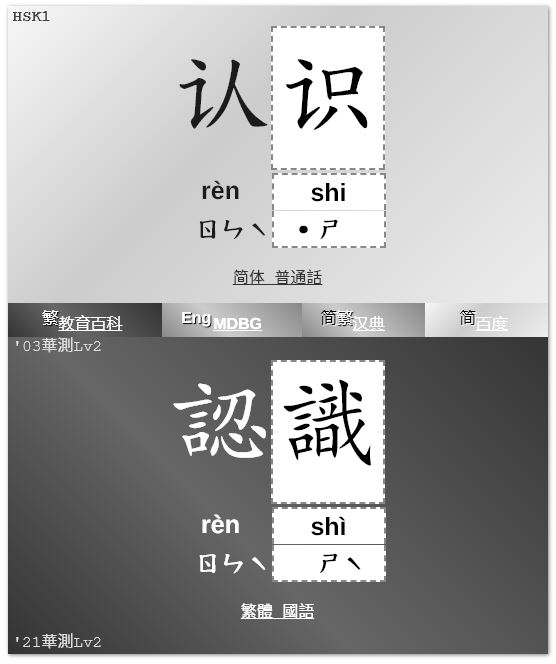
Words Source
詞源

華語文能力測驗TOCFL
“Hanyu Shuiping Kaoshi (HSK 汉语水平考试)” and “Test of Chinese as a Foreign Language (TOCFL 華語文能力測驗)” are two common language proficiency tests for non-native Chinese speakers in Australia. Both of them provide a “words list” to identify which words are more modern and commonly used in daily Chinese conversations. ToneOZ can limit the search range to phrases only from these two lists.
對於母語非華語的學生,會透過大型檢定考試來作做為中文學習成果的參考。「漢語水平考試(HSK)」及「華語文能力測驗(TOCFL)」是目前澳洲常見的兩種中文檢定考,兩者都有提供常用詞表做為出題依據(請參考以下連結)。澳聲通詞庫可以限定只搜尋詞表中的常用詞。
HSK表示「汉语水平考试」。
’03 TOCFL is the TOCFL word list between 2003~2020
’03 TOCFL 表示 2003年開始使用的「華語八千詞」。
’21 TOCFL is the TOCFL word list after 2021
’21 TOCFL 表示 2021年開始使用的「國教院詞語表」(TBCL)。
For following links are the original official sources of these words list:
以下為原始詞源官方下載連結:
* 资源中心–汉语考试服务网 Chinesetest.cn. Retrieved 2 May 2015. Link 新汉语水平考试(HSK)词汇(2012年修订版)
* 華語八千詞
* Taiwan Benchmarking Chinese Language (TBCL) 臺灣華語文能力基準 國教院三等七級詞表 (2021)
